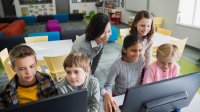Students’ Best Tech Resource: The Teacher
Three strategies to make sure your content—not your technology—is your students’ main focus.
Your content has been saved!
Go to My Saved Content.Growth in learning does not typically occur through technology used in isolation. It’s when instructional strategies and human interaction are used simultaneously with digital tools that learning experiences are best seeded for growth.
Consider a student using drill and practice software to learn math skills. Students can easily be distracted from the learning process by the excitement of getting to the reward at the end. And if the student is quickly clicking through the problems to get to that reward, they may not gain much understanding of the intended mathematical goal.
However, if the teacher integrates sound instructional choices to support the student when they’re using the software, it’s more likely that growth will occur. For example, the teacher could pair up students, remove the rewards in the software, and ask the students to probe each other’s thinking with questioning techniques. This would allow for joint media engagement and the opportunity for students to elicit reflective thinking. In addition, the teacher can model how to navigate the software to better support the learning rather than let students focus on the reward.
There are many effective instructional moves that teachers can draw upon when using technology. Here are three examples of instructional practices to elicit better learning with digital tools.
Guided Practice and Gradual Release of Responsibility
A common practice in literacy learning is to gradually release responsibility for learning over to students, through a modeling approach of “I do, we do, you do.” The same approach can be used when technology is part of a lesson.
In this strategy, the students first watch the teacher model the technology through direct instruction—the students do not use devices at this stage. Often this modeling process includes a software tour, in which teachers show their students how to use the software and ask them what they notice about it, such as the options for visual representations. Teachers can also ask students to visualize how they might use the tool, and have a discussion about that. While demonstrating the software, teachers will talk out loud about what they’re doing and why they’re making certain choices in the software.
The next step is for the children to get their devices and do the learning activity together with the teacher through guided practice. And finally, the teacher releases responsibility to the students so they can try the technology on their own. Here’s an example from a fourth-grade teacher.
Switcheroo
Learning is social, so it’s important that children engage with other people while using technology. In a switcheroo activity, the students work individually but end up engaging with each other through the technology. Students begin a switcheroo by doing individual work in the software (such as writing a story, working out a math problem, coming up with a hypothesis for a scientific experiment, etc.).
About halfway through the time, the teacher asks students to do a “switcheroo”—exchanging devices with another student. Students look over each other’s work and provide feedback. Teachers can also have students build on or add to the content—for example, by creating a collaborative story.
Reflective Thinking
Students should be encouraged to self-reflect on their activities in the software. Teaching students to use visible thinking routines can help them learn to ask reflective questions when using technology. As part of self-reflection, students should learn to make connections between what they are doing with technology tools and their everyday experiences. They should also connect those experiences to the content learning (such as in this example using Google Earth).
Teachers can also help students learn how to do self-reflection as they work with technology tools. Students should be asking themselves questions as they engage in the content. Part of reflection is learning how to generate predictions—by doing so the students will be able to probe the content in the software more deeply. Software such as Recap and Flipgrid helps to encourage prediction and self-reflection.
There are many more instructional strategies that teachers can use to help students get the most from classroom technology—check out the Triple E Framework website for some examples.
